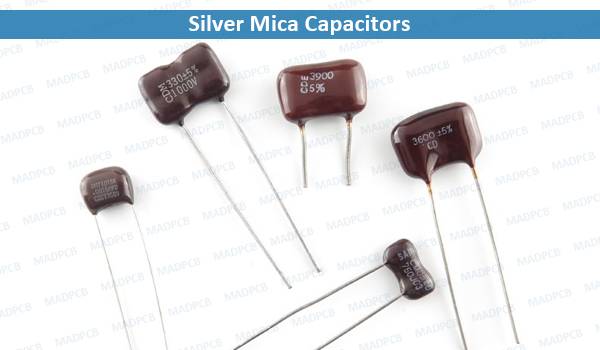What Are Silver Mica Capacitors?
Silver Mica Capacitors are capacitors which use mica as the dielectric, which have great high-frequency properties due to low resistive and inductive losses, and are very stable over time.
There are two types of mica capacitors:
- Clamped mica capacitors
- Silver mica capacitors
Clamped mica capacitors are now considered obsolete due to their inferior characteristics. Silver mica capacitors are used instead. They are made by sandwiching mica sheets coated with metal on both sides. This assembly is then encased in epoxy in order to protect it from the environment. Mica capacitors are generally used when the design calls for stable, reliable capacitors of relatively small values. They are low-loss capacitors, which allow them to be used at high frequencies, and their value does not change much over time.
Mica minerals are very stable electrically, chemically and mechanically. Because of its specific crystalline structure binding, it has a typical layered structure. This makes it possible to manufacture thin sheets in the order of 0.025-0.125 mm. The most commonly used are muscovite and phlogopite mica. The first has better electrical properties, while the second has a higher temperature resistance. Mica is delved in India, Central Africa and South America. The high variation in raw material composition leads to high cost needed for inspection and sorting. Mica doesn’t react with most acids, water, oil and solvents.
Precision and tolerances
The minimum tolerance for silver mica capacitor values can be as low as ±1%. This is much better than practically all other types of capacitors. In comparison, certain ceramic capacitors can have tolerances of up to ±20%.
Stability
Mica capacitors are very stable and very accurate. Their capacitance changes little over time. This is due to the fact that there are no air gaps in the design which could change over time. Also, the assembly is protected from moisture and other effects by an epoxy resin. This means that outside effects such as air humidity do not affect mica capacitors. Not only is their capacitance stable over time, it is also stable over a wide temperature, voltage and frequency range. The average temperature coefficient is around 50 ppm/°C.
Low losses
Mica capacitors have low resistive and inductive losses (high Q factor). Their characteristics are mostly frequency-independent, which allows for their use at high frequency. These superior characteristics come at a price (are bulky and expensive).
Construction and Properties of Mica capacitors
The construction of silver mica capacitors is relatively simple. Old clamped mica capacitors used thin sheets of mica layered with thin sheets of silver. These layers were clamped and electrodes were added. However, due to physical imperfections in both mica and silver layers, there were small air gaps present which limited the precision of clamped mica capacitors. Additionally, those air gaps could introduce problems due to mechanical stresses and the capacitance value would change over time.
Post-WW2 silver mica capacitors are made by plating the silver directly on the surface of mica and layering these to achieve the desired capacitance. After the layers are assembled, electrodes are added and the assembly is encapsulated. Ceramics or epoxy resins are used as encapsulation material in order to protect the silver-mica capacitor from outside effects such as moisture.
Silver mica capacitors have a relatively small capacitance value: usually between a few pF, up to a few nF. The largest capacitance mica capacitors can reach values of 1µF, although these are uncommon. These are usually rated for voltages between 100 and 1000 volts, although there are special high-voltage mica capacitors designed for RF transmitter use which are rated at up to 10 kV.
Applications for Mica Capacitors
Silver mica capacitors are used in applications which call for low capacitance values and high stability, while exhibiting low losses. Their main use is in power RF circuits where stability is of utmost importance.
Silver mica capacitors are used in high frequency tuned circuits, such as filters and oscillators. They are sometimes used in pulsed applications as snubbers. Although they were once very popular as quality capacitors, nowadays they are increasingly being replaced by other types of capacitors due to their size and cost, which can reach several USD a piece.
In low power RF applications, a good replacement for mica capacitors are ceramic capacitors. If capacitance tolerances and low losses are an important factor, Class 1 ceramic capacitors can be used, since these capacitors have similar tolerances at a fraction of the price.
In some applications, silver mica capacitors are still indispensable. For example, circuit designers still turn to mica capacitors for high-power applications such as RF transmitters. Another application where silver mica remains widely used are high-voltage applications, due to mica’s high breakdown voltage.

